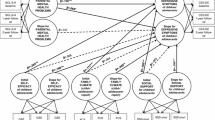Abstract
Depressive symptomatology contributes to morbidity and mortality across the life course. Among factors predicting adolescent depressive symptomatology, it has become increasingly important to identify factors that prevent or minimize it, i.e., protective factors. This study examines protective factors operating in three contextual domains (parental, school-related and individual) that hold promise for explicating their role in the prevention of depressive symptomatology among a non-clinical adolescent population in Hungary. Data from this cross-sectional survey were gathered using self-administered questionnaires from adolescents (N = 881; aged between 14 and 20 years; 44.6% females) from five randomly selected high schools in Szeged, Hungary. Multiple regression analyses revealed that individual level variables (i.e., life satisfaction and optimism) were important predictors of adolescent depressive symptomatology. Among parental variables, social support from the same-sex parents lowered depressive symptoms. In addition, having dinner together with one’s family was a significant protective factor for boys, whereas talking about problems with parents was significant for girls. In our study, school-related factors played only a limited role in reducing depressive symptoms; being happy with school was a protective factor only for boys. As a consequence, our findings draw attention to important gender differences in the structuring of protective factors and their role in reducing depressive symptoms, which will likely continue to be an important part of the prevention conversation.
Similar content being viewed by others
References
Adelman HS, Taylor L, Nelson P (1989) Minors’ dissatisfaction with their life circumstances. Child Psychiatr Hum Dev 20:135–147
Allen JP, Insabella G, Porter MR, Smith FD, Land D, Phillips N (2006) A social-interactional model of the development of depressive symptoms in adolescence. J Consult Clin Psychol 74(1):55–65
Armsden GC, McCauley E, Greenberg MT, Burke PM, Mitchell JR (1990) Parent and peer attachment in early adolescent depression. J Abnorm Child Psychol 18(6):683–697
Deković M (1999) Risk and protective factors in the development of problem behavior during adolescence. J Youth Adolesc 28:667–685
Diener E, Emmons RA, Larsen RJ, Griffin S (1985) The Satisfaction with Life Scale. J Pers Assess 49:71–75
Fitzpatrick KM (1997) Fighting among America’s youth: a risk and protective factors approach. J Health Soc Behav 38:131–148
Friedman RA (2006) Uncovering an epidemic—screening for mental illness in teens. N Engl J Med 355(26):2717–2719
Graham CA, Easterbrooks MA (2000) School-aged children’s vulnerability to depressive symptomatology: the role of attachment security, maternal depressive symptomatology, and economic risk. Dev Psychopathol 12(2):201–213
Hair EC, Moore KA, Garrett SB, Ling T, Cleveland K (2008) The continued importance of quality parent–adolescent relationships during late adolescence. J Res Adolesc 18(1):187–200
Jessor R, Van Den Bos J, Vanderryn J, Costa FM, Turbin MS (1995) Protective factors in adolescent problem behavior: moderator effects and development change. Dev Psychol 31:923–933
Koivumaa-Honkanen H, Kaprio J, Honkanen R, Viinamäki H, Koskenvuo M (2004) Life satisfaction and depression in a 15-year follow-up of healthy adults. Soc Psychiatr Psychiat Epidemiol 39:994–999
Kovacs M (1992) Children’s Depression Inventory (CDI). Multi-Health Systems, Toronto
Liu Y-L (2006) Paternal–maternal attachment, peer support, social expectations of peer interaction, and depressive symptoms. Adolescence 41:705–721
Luthar SS, Cichetti D, Becker B (2000) The construct of resilience: a critical evaluation and guidelines for future work. Child Dev 71(3):543–562
Manongdo JA, Garcia R (2007) Mothers’ parenting dimensions and adolescent externalizing and internalizing behaviors in a low-income, urban Mexican American sample. J Clin Child Adolesc Psychol 36(4):593–604
Piko B (2000) Perceived social support from parents and peers: which is the stronger predictor of adolescent substance use? Subst Use Misuse 35(4):617–630
Piko B (2006) Satisfaction with life, psychosocial health, and materialism among Hungarian youth. J Health Psychol 11(6):827–831
Piko B (1998) Social support and health in adolescence: a factor analytical study. Br J Health Psychol 3:333–344
Piko BF, Fitzpatrick KM (2003) Depressive symptomatology among Hungarian youth: a risk and protective factors approach. Am J Orthopsychiatr 73(1):44–54
Piko BF, Fitzpatrick KM (2002) Without protection: substance use among Hungarian adolescents in high-risk settings. J Adolesc Health 30:463–466
Rubin C, Rubenstein JL, Stechler G, Heeren T, Halton A, Housman D, Kasten L (1992) Depressive affect in “normal” adolescents: relationships to life stress, family, and friends. Am J Orthopsychiatr 62:430–441
Scharf M, Mayseless O, Kivenson-Baron I (2004) Adolescents’ attachment representations and developmental tasks in emerging adulthood. Dev Psychopathol 40(3):430–444
Scheier MF, Carver CS (1985) Optimism, coping and health: assessment and implications of generalized outcome experiences. Health Psychol 5:219–247
Search Institute (1998) Search Institute profiles of student life administration manual. Search Institute, Minneapolis
Seligman MEP (2002) Authentic happiness: using the new positive psychology to realize your potential for lasting fulfillment. Free Press, New York
Simons-Morton BG, Davis Crump A, Haynie DL, Saylor KE (1999) Student–school bonding and adolescent problem behavior. Health Educ Res 14:99–107
Somersalo H, Solantaus T, Almqvist F (2002) Classroom climate and the mental health of primary school children. Nord J Psychiatr 56:285–290
Steinhardt M, Dolbier C (2008) Evaluation of resilience intervention to enhance coping strategies and protective factors and decrease symptomatology. J Am Coll Health 56(4):445–453
Turner RJ, Marino F (1994) Social support and social structure: a descriptive epidemiology. J Health Soc Behav 35:513–519
Van Voorhees BW, Paunesku D, Kuwabara SA, Basu A, Gollan J, Hankin BL, Melkonian S, Reinecke M (2008) Protective and vulnerability factors predicting new-onset depressive episode in a representative of US adolescents. J Adolesc Health 42:605–616
Weist MD, Freedman AH, Paskewitz DA, Proescher EJ, Flaherty LT (1995) Urban youth under stress: empirical identification of protective factors. J Youth Adolesc 24:705–721
Author information
Authors and Affiliations
Corresponding author
Rights and permissions
About this article
Cite this article
Piko, B.F., Kovacs, E. & Fitzpatrick, K.M. What makes a difference? Understanding the role of protective factors in Hungarian adolescents’ depressive symptomatology. Eur Child Adolesc Psychiatry 18, 617–624 (2009). https://doi.org/10.1007/s00787-009-0022-y
Received:
Accepted:
Published:
Issue Date:
DOI: https://doi.org/10.1007/s00787-009-0022-y




